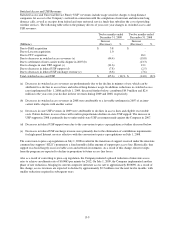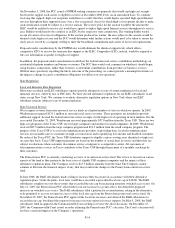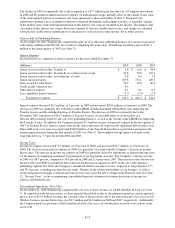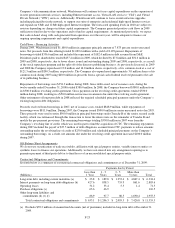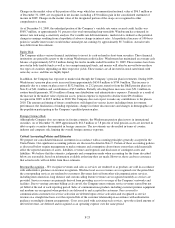Windstream 2009 Annual Report Download - page 130
Download and view the complete annual report
Please find page 130 of the 2009 Windstream annual report below. You can navigate through the pages in the report by either clicking on the pages listed below, or by using the keyword search tool below to find specific information within the annual report.
On November 5, 2008, the FCC issued a FNPRM seeking comment on proposals that would cap high-cost receipts
based on the support each carrier is eligible to receive at December 2008 levels on an annualized basis. To continue
receiving this support, high-cost recipients would have to certify that they would deploy specified high-speed Internet
services throughout their supported areas over a five-year period. Areas for which high-cost recipients decline to make
such certification would be subject to a reverse auction. The reserve price for the auction would be the amount the
ILEC would be entitled to receive if it would have agreed to deploy high-speed Internet services throughout its service
area. Bidders would need to be certified as an ETC by the respective state commission. The winning bidder would
accept all carrier of last resort obligations. If the auction produced no winner, the area subject to the auction would be
deemed a truly high-cost area and the FCC would determine what further actions would need to be taken to ensure the
study area is served by a company willing to meet the broadband commitment and carrier of last resort requirements.
Proposals under consideration by the FNPRM also would eliminate the identical support rule, which allows
competitive ETCs to receive the same per line support as the ILEC. Competitive ETCs, instead, would be required to
file cost information to qualify for high-cost support.
In addition, the proposals under consideration would base the federal universal service contribution methodology on
residential telephone numbers and business revenues. The FCC then would seek comment on whether it should begin
using business connections, rather than revenues, to determine contributions from providers of business services.
Without more specificity regarding the likely outcome of the proceeding, we cannot provide a meaningful estimate of
the impact a change in carrier contribution obligations would have on our operations.
State Regulation
Local and Intrastate Rate Regulation
Most states in which our ILEC subsidiaries operate provide alternatives to rate-of-return regulation for local and
intrastate services, either by law or PSC rules. We have elected alternative regulation for our ILEC subsidiaries in all
states except New York. We continue to evaluate alternative regulation options in New York where our ILEC
subsidiary remains subject to rate-of-return regulation.
State Universal Service
We recognize revenue from state universal service funds in a limited number of states in which we operate. In 2009,
Windstream recognized $131.1 million in state universal service revenue. These payments are intended to provide
additional support, beyond the federal universal service receipts, for the high cost of operating in rural markets. For the
year ended December 31, 2009, Windstream received approximately $97.8 million from the Texas USF. There are two
high-cost programs of the Texas USF, one for large companies and another for small companies. In 2009, Windstream
received $85.5 million from the large company program and $12.3 million from the small company program. The
purpose of the Texas USF is to assist telecommunications providers in providing basic local telecommunications
services at reasonable rates to customers in high cost rural areas and to qualifying low-income and disabled customers.
By order of the Texas PUC, the Texas USF distributes support to eligible carriers serving areas identified as high cost,
on a per-line basis. Texas USF support payments are based on the number of actual lines in service and therefore are
subject to reductions when customers discontinue service or migrate to a competitive carrier. All customers of
telecommunications services in Texas contribute to the Texas USF through the payment of a monthly surcharge by
their customers.
The Pennsylvania PUC is currently conducting a review of its universal service fund. The review is focused on various
aspects of the fund as they pertain to the basic rates of eligible USF recipient companies and the impact of their
alternative regulation plans. The Company receives $13.3 million annually from the fund. The Company cannot
estimate at this time the financial impact, if any, that may result from changes to the Pennsylvania universal service
fund.
In June 2006, the D&E subsidiaries made a filing to increase their local rates in accordance with their alternative
regulation plans. Under the plans, local rates would have exceeded a prescribed local rate cap of $18.00. The D&E
subsidiaries sought to recover the revenues that exceeded the rate cap by increasing intrastate switched access rates. On
July 11, 2007, the Pennsylvania PUC allowed the local rate increases to go into effect, but denied the proposed
increases in switched access rates. The D&E subsidiaries filed a petition for reconsideration, asking in the alternative,
to be permitted to recover revenues in excess of the local rate cap from the Pennsylvania universal service fund. On
November 29, 2007, the Pennsylvania PUC approved the local rate increases and allowed the D&E subsidiaries to
exceed the rate cap, but denied the request for increases in state universal service support. On May 9, 2008, the D&E
subsidiaries filed an appeal in the Commonwealth Court seeking to reverse the above decisions. On December 15,
2009, the Commonwealth Court issued an order affirming the Pennsylvania PUC’s decision. The Court’s decision will
not have a material impact on the Company’s operations.
F-16





